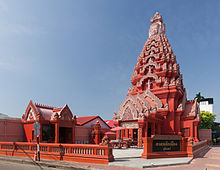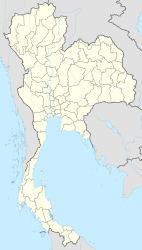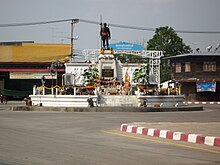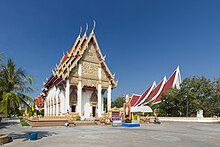Surin
|
สุรินทร์ Surin |
||
|---|---|---|
|
|
||
| Coordinates | 14 ° 53 ' N , 103 ° 30' E | |
| Symbols | ||
|
||
| Basic data | ||
| Country | Thailand | |
| Surin | ||
| ISO 3166-2 | TH-32 | |
| Residents | 40,096 (2012) | |

Surin ( Thai สุรินทร์ , pronunciation: [sùʔrin] ) is the capital of the Thai province of Surin in the northeast region of the country. It has the status of a “ city commune ” ( เทศบาล เมือง สุรินทร์ ) and is located in the district ( Amphoe ) Mueang Surin .
The city of Surin has 40,096 inhabitants (as of 2012).
geography
The province of Surin is located in the northeast region of Thailand , the so-called Isan . The city of Surin is located on the southern edge of the Khorat plateau , a level that is very dry during the hot season and flooded during the rainy season . The distance to the capital Bangkok is about 460 kilometers.
history
Surin was originally an old Khmer settlement, as evidenced by the many ruins of Khmer temples. It was not until 1763 that a village was founded on the site of today's Surin, which later grew into a city ( Müang ) and was called "Mueang Prathai Saman". At that time a man named Chiangpum is said to have lived here, who gave a white elephant as a tribute to Chao Phraya Chakri, who later became King Phra Phutthayotfa Chulalok ( Rama I ) . He was therefore given the title of "Luang Surin Phakdi" and appointed head of the city. When King Phra Phutthayotfa ascended the throne, Luang Surin Phakdi became the first governor as Phraya Surin Phakdi Si Narong Changwang, and in 1786 the city got its current name.
Economy and Importance
The best elephant handlers ( mahouts ), mostly members of the Kui minority, are said to come from this area .
Surin is the trade and supply center for the almost exclusively agricultural region. The region's economic products are mainly rice , but also sugar cane , jute , silk , maize and tapioca . In many villages, baskets are woven and silk fabrics are made outside of the rice harvest season .
traffic
Airport
- Surin Pakdee Airport (Thai: ท่าอากาศยาน สุรินทร์ ภักดี , military)
- Buriram Airport (around 50 km away)
railroad
Surin has a train station on the Nakhon Ratchasima – Ubon Ratchathani railway line , an extension of the northeast railway coming from Bangkok .
education
- Surindra Rajabhat University
- Rajamangala Isan Technical University (RMUTI) Surin campus
Attractions
- Khmer ruins - just outside the city there are numerous largely unknown, but worth seeing remains of the ancient Khmer culture from the 10th century :
- Prasat Hin Ban Phuluang (ปราสาทหิน บ้าน พลวง )
- Prasat Tamuan Tot ( ปราสาท ตา เมือง โต๊ จ )
- Prasat Tamuan Thom ( ประสาท ตา เมือง ธ ม )
- Prasat Sikhoraphum ( ปราสาท ศรี ข ร ภูมิ )
- Prasat Yai Ngao ( ปราสาท ยาย เหงา )
Surin, the elephant city
On the third weekend in November, around 200 elephants from all over Thailand compete against each other in skill, perseverance and obedience over several days at the elephant lift (folk festival).
Surin owes its reputation as an elephant city primarily to the village of Ban Ta Klang (Thai: บ้าน ตา กลาง , also หมู่บ้าน ช้าง - elephant village ) in the Amphoe Tha Tum, about 58 km from the provincial capital Surin. Most of the inhabitants of this village belong to the Suay (Thai: ส่วย ) minority . This ethnic group, whose language differs greatly from both the Thai language and the Cambodian dialect predominantly spoken in this border area with Cambodia, is known for its tradition of raising elephants and using them as working animals. For centuries the Suay men have caught wild elephants in the jungles of northern Thailand and Cambodia, tamed them and trained them as war elephants for the rulers of the country, or as workhorses for forest work.
While there were around 10,000 elephants in Thailand at the beginning of the seventies, their population has since decreased dramatically due to the ever increasing circumcision of their habitat: There are likely to be around 3,000 domesticated elephants in Thailand today and only around a hundred animals that live in the wild in the national parks.
So although the times are long gone when you could hunt and catch wild elephants in the forests, since the forests have long since fallen victim to overexploitation , for these people the elephants are still part of their lives. The center of pachyderm is the village of Ban Ta Klang, about 20 km north of Surin, where almost every second family has one or more elephants. However, those who undertake the long journey to this village on their own to see elephants in their natural environment will often be disappointed. The pachyderms are mostly in the tourist resorts where they have to earn their food, and the elephants remaining in the village are taken to graze in the surrounding bush forests during the day.
Once every year in November, the elephant festival, which is visited by many tourists as an attraction, takes place in Surin, which is also the big annual event for the entire population. During this elephant lift, around 100 pachyderms demonstrate what they have learned and what tricks they have been taught, e.g. B. their skill in transporting logs. The elephants also hold regular sports competitions with relay runs, basketball and tug of war and even a football game with elephants is offered. A parade of armored war elephants usually concludes the festivities. In a colorful show, pictures and fights from Thai history are reproduced, in which the elephants played an important role, giving the visitor a little insight into the eventful history of Thailand.
In the past, the elephants were mainly used to work in the timber industry. Since logging was banned by the government, there has been no employment for the animals here. The lack of employment today forces the owners to find a different livelihood for themselves and the animals. That is why they try to earn money with Farang visitors in particular .
They move south to Bangkok, or to the tourist centers of Pattaya or Phuket , and earn their living there by offering a ride on the elephant, or by pulling along the beach during the day and at the bars in the evening, and the tourists the elephants with bananas and feed sugar cane. The completely different way of life to which these animals are exposed brings a lot of health problems and dangers, especially for the young animals.
Personalities
Born here
- Tony Jaa (* 1976), actor
- Chayanisa Chomchuendee (* 1988), pole vaulter
- Yuttana Ruangsuksut (* 1989), football player
- Anusorn Srichaluang (* 1989), soccer player
- Siroch Chatthong (* 1992), soccer player
- Sarawut Inpaen (* 1992), football player
- Yotsapon Teangdar (born 1992), football player
- Kittipong Wongma (born 1995), soccer player
- Kevin Sangsamanan (born 1997), soccer player
- Nutchanon Soijit (* 1997), football player
- Panyawat Nisangram (* 1999), football player
Web links
Individual evidence
- ↑ Department of Provincial Administration , as of 2012 ( Thai ).
- ↑ Gerhard Gronefeld : The largest elephant festival in the world, in: ders .: On the trail of the gray colossi, in: The great youth book 26th episode. Stuttgart 1985. pp. 84-91, here 91.






